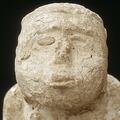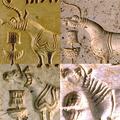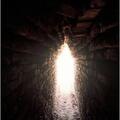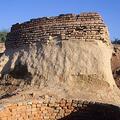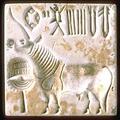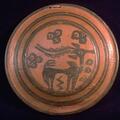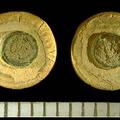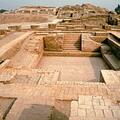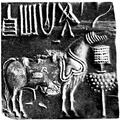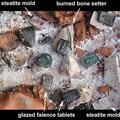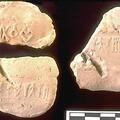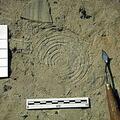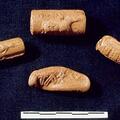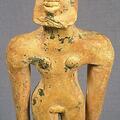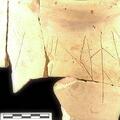Seated male sculpture from Mohenjo-daro with shell inlay still remaining in one eye. The braided or combed hair lays back straight and a plain fillet or ribbon encircles the head and falls down the back of the neck.
344 posts, also carried on our Facebook page, about the ancient Indus Valley civilization, including important news, research and occasional visits to museums with ancient Indus artifacts.
Feb 8, 2014
Richard H. Meadow at Harvard wrote in response to a question about whether the so-called unicorn seal depicts a mythical animal or a composite: "Some believe the one, some the other.
Jan 24, 2014
The corbelled arch drain from the great bath in Mohenjo-daro is large enough to walk into. It has a small ledge on either side of the actual drain channel.
See also Mohenjo-daro: City of Wells.
Jan 15, 2014
One of only eight wells, public and private, that have thus far been discovered at Harappa. Most of the water used by the population probably came from the adjacent Ravi River. The curved wall was probably a large drain used during the latter stages of ancient
Jan 12, 2014
A steatite unicorn seal from Harappa with Indus script and dating to around 2450-2200 BCE. When pressed into clay the impression will be reversed.
Jan 8, 2014
Late Harappan Period dish or lid with perforation at edge for hanging or attaching to large jar. It shows a Blackbuck antelope with trefoil design made of combined circle-and-dot motifs, possibly representing stars. It is associated with burial pottery of the
Dec 22, 2013
Two gold beads originally part of the same ornament found in Harappa in 2000. Thin gold foil was placed over the outside of a sandy core around a copper tube. For more information about gold and Indus culture, read Jonathan Mark Kenoyer's article Wealth and
Dec 7, 2013
The "great bath" is without doubt the earliest public water tank in the ancient world. The tank itself measures approximately 12 meters north-south and 7 meters wide, with a maximum depth of 2.4 meters.
Nov 24, 2013
Further to the discussion of chimeras, among the first unicorn seals found by John Marshall at Mohenjo-daro in the 1920's was this one.
Nov 19, 2013
Fully and partially glazed faience tablets and other fired objects could be examined after the fire had cooled and the canister opened during experimental firings at the University of Madison, Wisconsin.
Sep 21, 2013
Three clay sealings from the Harappa Phase levels (2600-1900 BCE) that may have come from large bundles of goods shipped to the site from a distant region.
Sep 16, 2013
From the school of careful excavations: a Kot Diji phase (2800-2600 BCE) coiled basketry impression unearthed at Harappa in 2000.
See also Kot Diji Phase Kiln
Sep 2, 2013
Terra cotta tokens or tablets from Harappa. In Area G, south of the gateway on Mound ET, excavators found a concentration of as many as 31 identical cylindrical terracotta tablets (top center), but it is not known what they could have been used for.
Jul 26, 2013
Nude male figurine or deity from Mohenjo-daro. Note the wide, spreading beard. He is wearing a broken headdress that may have had two curving horns. For additional information on the representation of masculinity, see also Men of Harappa A and Men of Harappa B
Jun 20, 2013
Many large storage jars of the (Period 3) Harappa Phase (2600-1900 BCE) have writing inscribed along the upper portion of the vessel. This inscription includes a figure of a man with the bow and arrow sign in each hand.

